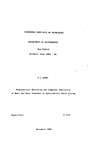JavaScript is disabled for your browser. Some features of this site may not work without it.
| dc.contributor.advisor | Laws, N. | |
| dc.contributor.author | Parry, J. L. | |
| dc.date.accessioned | 2009-08-28T12:12:50Z | |
| dc.date.available | 2009-08-28T12:12:50Z | |
| dc.date.issued | 1983-11 | |
| dc.identifier.uri | http://hdl.handle.net/1826/3636 | |
| dc.description.abstract | Mathematical modelling and computer simulation of grain drying are now widely used in agricultural engineering research. Several models have been proposed to describe the heat and mass transfer processes in the basic types of convective grain drier. Most of these models, however, have been derived under assumptions which are not explicitly stated and which restrict their applications from the outset. Furthermore, the differences which exist between various models are not always clarified in the literature. It is important with an ever-increasing demand for the accurate modelling of drying systems, for the researcher to understand the basic assumptions inherent in a particular model and hence to be aware of its limitations. In addition, the problems of obtaining satisfactory solutions for particular models have generally been given only a cursory treatment. The purpose of this work is, firstly, to provide a general framework from which mathematical models for any type of drier may be derived under suitable assumptions. The use of this framework is illustrated by the formulation of models for the four basic types of convective grain drier, namely fixed bed, concurrent flow, counterflow and crossflow. Previous work is then discussed in the context of these models. The resulting systems of differential equations for each of the models obtained are non-linear and have, in general, no analytical solution. The analytical/semi-analytical solutions to particular problems associated with the above cases are pursued as far as possible. However, as is evident from this investigation, purely numerical techniques provide the only practicable means of obtaining an accurate solution to any grain drying problem of current interest. Therefore, suitable computational techniques were devised and implemented for the solution of the three distinct cases, namely the fixed bed, steadystate concurrent flow and steady-state counterflow problems. These techniques are described together with appropriate validation cases. | en_UK |
| dc.language.iso | en | en_UK |
| dc.publisher | Cranfield University | en_UK |
| dc.title | Mathematical modelling and computer simulation of heat and mass transfer in agricultural grain drying | en_UK |
| dc.type | Thesis or dissertation | en_UK |
| dc.type.qualificationlevel | Doctoral | en_UK |
| dc.type.qualificationname | PhD | en_UK |
